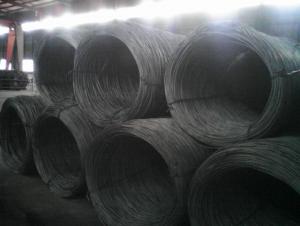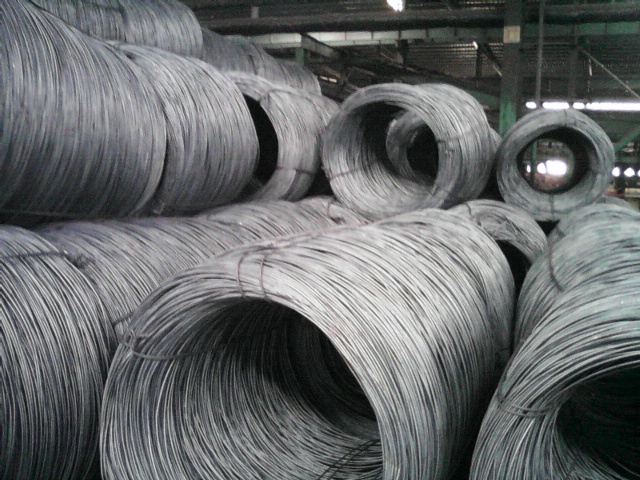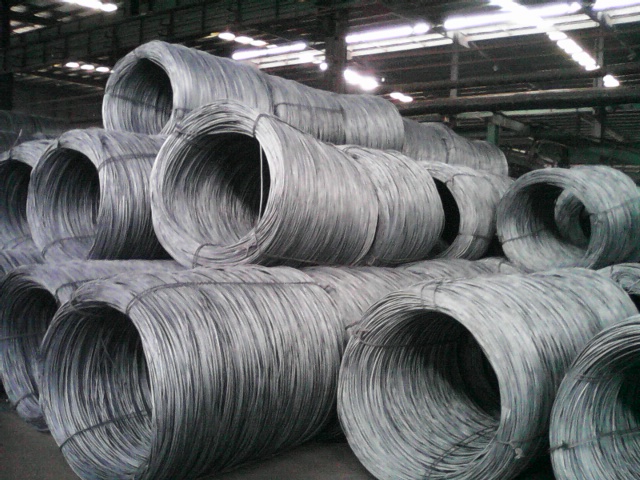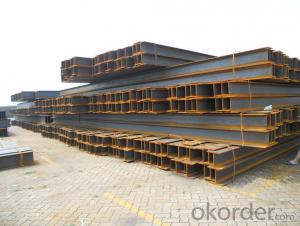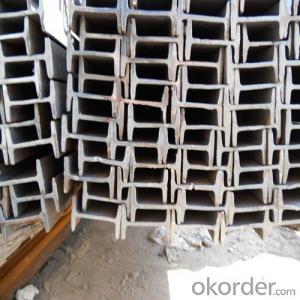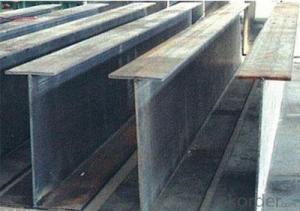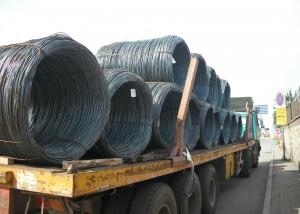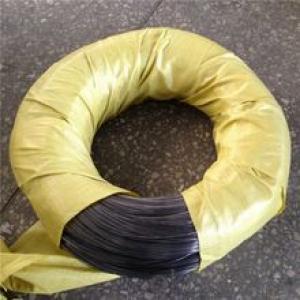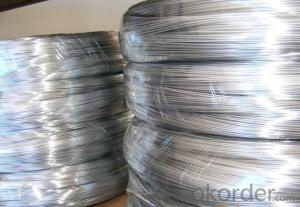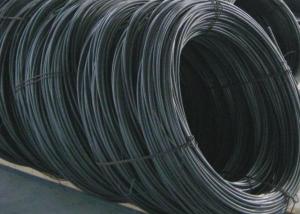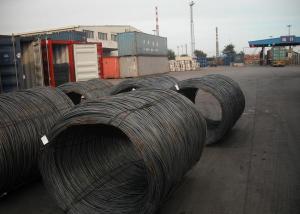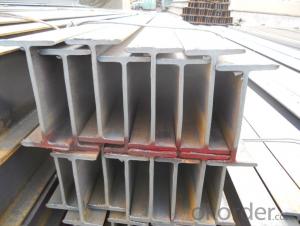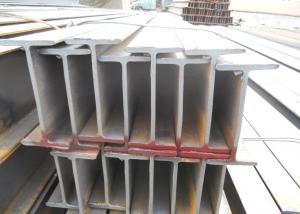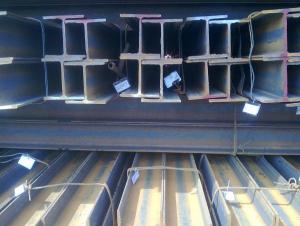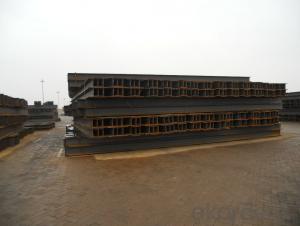HR Steel Wire Rod
- Loading Port:
- Tianjin
- Payment Terms:
- TT OR LC
- Min Order Qty:
- -
- Supply Capability:
- 200000 m.t./month
OKorder Service Pledge
OKorder Financial Service
You Might Also Like
Specifications of Hot Rolled Wire Rod:
Steel Grade: Q195/235, SAE1006-1018B Standard: ASTM, GB
Diameter: 5.5mm, 6.5mm, 7mm,8mm,9mm,10mm,12mm,14mm
Type: in coil, coil weight around 2MT Alloy or Not: Alloy
Technique: Hot Rolled Place of Origin: China Mainland
Surface: round, no twisted, light and smooth Brand Name: HSKY
Chemical Composition: (Please kindly find our chemistry of our material based on Q195、Q235A and Q235B as below for your information)
| Trademark | Rank | Chemical composition (quality score) % | ||||
| C | Si | Mn | S | P | ||
| ≤ | ≤ | ≤ | ||||
| Q195 | 0.06-0.12 | 0.30 | 0.25 | 0.050 | 0.045 | |
| Q235 | A | 0.14-0.22 | 0.30 | 0.30-0.65 | 0.050 | 0.045 |
| Q235 | B | 0.12-0.20 | 0.30 | 0.30-0.70 | 0.045 | 0.045 |
Usage and Applications of Hot Rolled Wire Rod:
After hot-rolled the products shaped into coil and delivery as finished product, including round, square, rectangular, hexagonal and so on. Since most of the products are round, it is generally called wire rod. Carbon steel wire rod is widely used in construction and manufacturing. Carbon steel wire rod is mainly used for reinforcement of reinforced concrete and welded structure or reprocessed (roberts , nail, etc.) materials, especially used to produce wire drawing, welding electrode, nails, spring, electronic, precise machinery parts and so on.
Packaging & Delivery of Hot Rolled Wire Rod:
Packaging Detail: products are packed in coil, each coil weight around 2 MT, and then shipped by container or bulk vessel
Delivery Detail: within 45 days after received deposit or LC.
Label: to be specified by customer, generally, each bundle has 1-2 labels
Trade terms: FOB, CFR, CIF
Hot Rolled Wire Rod in Container
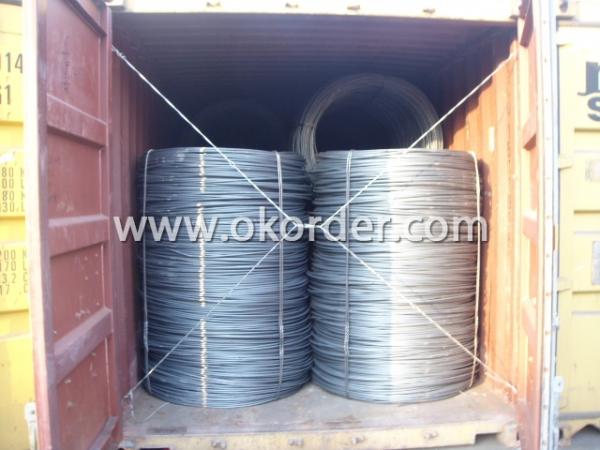
Hot Rolled Wire Rod in Bulk Vessel
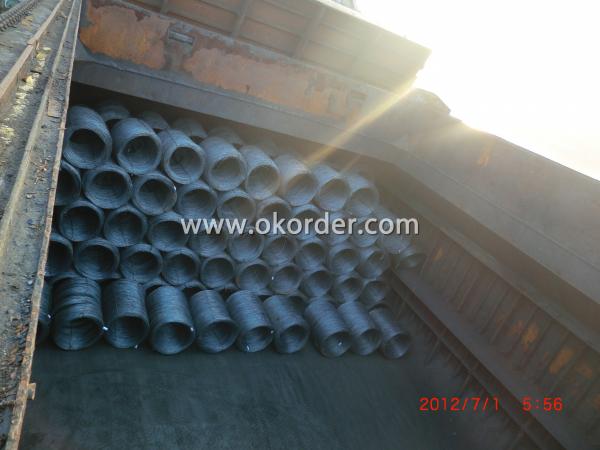
Note:
1. Our products are produced according to national standard (GB), if not, supply according to national standards (GB) or agreement as customer required.
2. Other Grade and Standard carbon steel wire rod we can supply:
Grade: H08A, 30MnSi, 62B-82B
Standard: AISI, BS, JIS, DIN
The Minimum Order Quantity of these products is high, and need to be confirmed.
3. We can not only supply carbon steel wire rod; if you need anything about building materials, please contact us.
4. Please send us your detail specifications when inquire. We will reply to you as soon as possible. We sincerely hope we can establish a long stable business relationship.
- Q: What are the different types of connections for steel H-beams?
- Steel H-beams can be connected in various ways, depending on the application and structural needs. Some common connection types for steel H-beams include: 1. Utilizing Welding: Welding is a widely used method for connecting steel H-beams. In this technique, the flanges and web of the H-beam are welded to either the supporting structure or other H-beams. Welded connections offer exceptional strength and rigidity, making them suitable for a wide range of uses. 2. Employing Bolts: Bolts and nuts are used in bolted connections to connect the flanges and web of the H-beam to either the supporting structure or other H-beams. Bolted connections have the advantage of easy disassembly and reassembly, making them suitable for applications that may require modifications or dismantling in the future. 3. Considering Rivets: Although less common nowadays, riveted connections were once widely used. In a riveted connection, rivets, which are metal fasteners hammered or pressed into place, are used to connect the flanges and web of the H-beam. Riveted connections offer good strength and durability but can be time-consuming and labor-intensive to install and dismantle. 4. Specialized Moment Connections: Moment connections are specialized connections used when there is a need to transfer vertical and horizontal loads, as well as rotational forces or moments. These connections typically involve a combination of welding and bolting to ensure the connection's structural integrity under various load conditions. 5. Shear Connections: Shear connections are used to transfer shear forces between H-beams or between the H-beam and the supporting structure. They can be achieved by welding or bolting plates or angles to the flanges of the H-beams, providing a secure and stable connection. Ultimately, the selection of a connection type for steel H-beams depends on factors such as structural requirements, load conditions, ease of installation, and future maintenance considerations. It is advisable to consult a structural engineer or a professional fabricator to determine the most suitable connection type for a specific application.
- Q: How do Steel H-Beams contribute to the overall natural disaster resilience of a structure?
- Steel H-Beams play a crucial role in enhancing the overall natural disaster resilience of a structure. These beams are specifically designed to provide strength, stability, and flexibility, making them an ideal choice for withstanding extreme forces and impacts. Here are a few ways in which steel H-beams contribute to the overall natural disaster resilience of a structure: 1. Structural Stability: Steel H-beams offer exceptional structural stability, making them highly resistant to the forces exerted by natural disasters such as earthquakes, hurricanes, and high winds. Their robust design ensures that the structure remains intact even under extreme conditions, reducing the risk of collapse and potential harm to occupants. 2. Load-Bearing Capacity: H-beams have a high load-bearing capacity, allowing them to support heavy loads and distribute the weight effectively throughout the structure. This feature is crucial during natural disasters, where the structure may experience additional loads due to strong winds, heavy rainfall, or debris impact. The ability of steel H-beams to withstand these loads enhances the overall resilience of the structure. 3. Flexibility and Ductility: Steel H-beams possess excellent flexibility and ductility, enabling them to absorb and dissipate energy during seismic events or strong winds. This flexibility prevents the structure from becoming rigid and brittle, which can lead to failure. The ability of H-beams to flex and sway helps in dissipating the forces imposed by natural disasters, reducing the risk of structural damage. 4. Fire Resistance: Steel H-beams have inherent fire-resistant properties, which is crucial for natural disaster resilience. In the event of a fire caused by a disaster, steel beams do not combust or contribute to the spread of flames. This fire resistance allows occupants more time to evacuate safely and minimizes the risk of structural failure due to fire. 5. Longevity and Durability: Steel H-beams are highly durable and resistant to corrosion, ensuring their longevity and structural integrity even in harsh environmental conditions. This durability is vital for the long-term resilience of a structure against natural disasters, as it minimizes the need for regular repairs and replacements. In summary, steel H-beams significantly contribute to the overall natural disaster resilience of a structure by providing structural stability, load-bearing capacity, flexibility, fire resistance, and durability. Their ability to withstand extreme forces and impacts enhances the safety of occupants and reduces the risk of structural failure during natural disasters.
- Q: Can steel H-beams be used for retail buildings?
- Yes, steel H-beams can be used for retail buildings. They are commonly used in commercial construction due to their strength, durability, and versatility. Steel H-beams provide structural support and can withstand heavy loads, making them suitable for retail buildings that may require spacious open areas and multiple floors. Additionally, their ability to span long distances without the need for additional support columns allows for flexible interior layouts in retail spaces.
- Q: What are the common applications of steel H-beams?
- Steel H-beams are widely used in various construction projects, especially in the structural and civil engineering fields. Some of the common applications of steel H-beams include: 1. Building Construction: Steel H-beams are frequently used as load-bearing members in the construction of buildings and other structures. They provide excellent strength and stability, making them ideal for supporting heavy loads and resisting various forces, such as wind and earthquakes. 2. Bridges: Steel H-beams are extensively used in the construction of bridges due to their ability to withstand high loads and support large spans. They are commonly used as main girders and piers, providing the necessary structural support to ensure the stability and durability of the bridge. 3. Industrial Structures: Steel H-beams are commonly used in the construction of industrial structures, such as warehouses, factories, and power plants. These structures often require large open spaces without the need for intermediate columns, and steel H-beams can provide the necessary strength and rigidity to fulfill these requirements. 4. Mezzanine Floors: Mezzanine floors are intermediate floors that are constructed within a building to create additional usable space. Steel H-beams are often used to support these floors, as they can efficiently bear the weight of the added load and allow for flexible space utilization. 5. Platforms and Walkways: Steel H-beams are frequently used to construct platforms and walkways in industrial settings, such as oil refineries, chemical plants, and power stations. These structures require high strength and stability to ensure the safety of workers and equipment, and steel H-beams are well-suited for this purpose. 6. Steel Frames: Steel H-beams are an essential component in the construction of steel frames for various structures. They form the skeleton of the building, providing the necessary support and stability to the overall structure. 7. Architectural Applications: Steel H-beams are also used in architectural applications to create unique and aesthetically pleasing structures. They can be used as decorative elements, such as exposed beams and columns, to enhance the visual appeal of buildings. In summary, steel H-beams find wide applications in the construction industry, including building construction, bridges, industrial structures, mezzanine floors, platforms and walkways, steel frames, and architectural designs. Their strength, stability, and versatility make them an essential component in various construction projects.
- Q: Can Steel H-Beams be used in marine or waterfront construction?
- Yes, steel H-beams can be used in marine or waterfront construction. Steel H-beams are commonly used in various construction projects due to their strength, durability, and versatility. They have a high load-bearing capacity, making them suitable for supporting heavy structures and resisting the forces exerted by water or waves. In marine or waterfront construction, steel H-beams can be used for various applications such as constructing piers, docks, bridges, seawalls, and other waterfront structures. The steel material is corrosion-resistant, which is important in a marine environment where exposure to saltwater and moisture can cause rapid deterioration of other materials. Additionally, steel H-beams can be easily fabricated, allowing for customized designs and precise construction. Overall, steel H-beams are a reliable choice for marine or waterfront construction due to their strength, durability, corrosion resistance, and adaptability to various construction needs.
- Q: Can Steel H-Beams be used in modular or prefabricated construction?
- Yes, Steel H-Beams can be used in modular or prefabricated construction. They provide structural support and can be easily assembled or disassembled, making them suitable for modular construction methods.
- Q: Are steel H-beams suitable for supporting gantry cranes?
- Yes, steel H-beams are suitable for supporting gantry cranes. H-beams are designed to provide excellent strength and load-bearing capacity, making them ideal for supporting heavy equipment such as gantry cranes. The shape of the H-beam allows for a greater distribution of weight, ensuring stability and minimizing the risk of bending or collapsing under the crane's load. Additionally, steel is a durable and long-lasting material that can withstand the constant stress and strain exerted by the crane. Therefore, using steel H-beams as the support structure for gantry cranes is a reliable and safe choice.
- Q: How do steel H-beams compare to concrete beams in terms of construction speed?
- Steel H-beams are generally faster to construct compared to concrete beams. This is primarily due to the nature of steel as a material, which allows for easier and faster fabrication and assembly. Steel H-beams can be prefabricated off-site, allowing for efficient mass production and faster delivery to the construction site. In contrast, concrete beams require more time for construction. The process involves multiple steps, such as formwork installation, pouring and curing of the concrete, and removal of the formwork. These steps take time to complete, and the curing process alone can take several days or even weeks, depending on the size and complexity of the beams. Moreover, steel H-beams are lighter in weight compared to concrete beams, making them easier to handle and install. This results in reduced labor requirements and shorter construction timelines. Additionally, steel beams can be easily adjusted or modified on-site, allowing for faster adjustments during the construction process. Overall, steel H-beams offer significant advantages in terms of construction speed compared to concrete beams. Their prefabrication capabilities, lighter weight, and ease of installation contribute to faster construction timelines, ultimately saving time and costs in the construction process.
- Q: How do steel H-beams perform in mining and industrial facilities?
- Due to their exceptional performance and durability, steel H-beams are extensively utilized in mining and industrial facilities. These beams possess several key qualities that make them the preferred choice in these settings. To begin with, steel H-beams offer remarkable structural strength and load-bearing capacity. They are specifically designed to withstand heavy loads and provide a high level of stability, making them ideal for supporting large structures and equipment commonly found in mining and industrial environments. In addition, steel H-beams exhibit excellent resistance to corrosion and can endure harsh conditions such as high humidity, extreme temperatures, and exposure to various chemicals. This corrosion resistance ensures the longevity and reliability of the beams, minimizing the need for frequent maintenance or replacement. Another advantage of steel H-beams lies in their versatility. They can be easily fabricated and customized to meet specific project requirements. This flexibility allows for seamless integration into different mining and industrial applications, such as supporting conveyor belts, constructing platforms, or creating structural frameworks. Furthermore, steel H-beams provide enhanced fire resistance compared to other construction materials. In the event of a fire, these beams retain their structural integrity for a longer duration, allowing more time for evacuation and reducing the risk of collapse. Moreover, steel H-beams boast a high recyclability rate, making them an environmentally friendly choice. Once they reach the end of their lifespan, these beams can be easily recycled and reused in other applications, minimizing waste and promoting sustainability. In conclusion, steel H-beams are highly suitable for mining and industrial facilities due to their exceptional strength, durability, corrosion resistance, versatility, fire resistance, and recyclability. Their performance in these environments ensures the safety, stability, and longevity of structures and equipment, making them the preferred choice for various applications in these industries.
- Q: Are steel H-beams suitable for structures with high humidity?
- Steel H-beams are generally suitable for structures with high humidity due to their inherent corrosion resistance. However, it is important to consider protective coatings and regular maintenance to prevent any potential corrosion issues in such environments.
Send your message to us
HR Steel Wire Rod
- Loading Port:
- Tianjin
- Payment Terms:
- TT OR LC
- Min Order Qty:
- -
- Supply Capability:
- 200000 m.t./month
OKorder Service Pledge
OKorder Financial Service
Similar products
Hot products
Hot Searches
Related keywords
